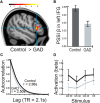Clinically Anxious Individuals Show Disrupted Feedback between Inferior Frontal Gyrus and Prefrontal-Limbic Control Circuit
- PMID: 27122030
- PMCID: PMC6601720
- DOI: 10.1523/JNEUROSCI.1092-15.2016
Clinically Anxious Individuals Show Disrupted Feedback between Inferior Frontal Gyrus and Prefrontal-Limbic Control Circuit
Abstract
Clinical anxiety is associated with generalization of conditioned fear, in which innocuous stimuli elicit alarm. Using Pavlovian fear conditioning (electric shock), we quantify generalization as the degree to which subjects' neurobiological responses track perceptual similarity gradients to a conditioned stimulus. Previous studies show that the ventromedial prefrontal cortex (vmPFC) inversely and ventral tegmental area directly track the gradient of perceptual similarity to the conditioned stimulus in healthy individuals, whereas clinically anxious individuals fail to discriminate. Here, we extend this work by identifying specific functional roles within the prefrontal-limbic circuit. We analyzed fMRI time-series acquired from 57 human subjects during a fear generalization task using entropic measures of circuit-wide regulation and feedback (power spectrum scale invariance/autocorrelation), in combination with structural (diffusion MRI-probabilistic tractography) and functional (stochastic dynamic causal modeling) measures of prefrontal-limbic connectivity within the circuit. Group comparison and correlations with anxiety severity across 57 subjects revealed dysregulatory dynamic signatures within the inferior frontal gyrus (IFG), which our prior work has linked to impaired feedback within the circuit. Bayesian model selection then identified a fully connected prefrontal-limbic model comprising the IFG, vmPFC, and amygdala. Dysregulatory IFG dynamics were associated with weaker reciprocal excitatory connectivity between the IFG and the vmPFC. The vmPFC exhibited inhibitory influence on the amygdala. Our current results, combined with our previous work across a threat-perception spectrum of 137 subjects and a meta-analysis of 366 fMRI studies, dissociate distinct roles for three prefrontal-limbic regions, wherein the IFG provides evaluation of stimulus meaning, which then informs the vmPFC in inhibiting the amygdala.
Significance statement: Affective neuroscience has generally treated prefrontal regions (orbitofrontal cortex, dorsolateral prefrontal cortex, inferior frontal gyrus, ventromedial prefrontal cortex) equivalently as inhibitory components of the prefrontal-limbic system. Yet research across the anxiety spectrum suggests that the inferior frontal gyrus may have a more complex role in emotion regulation, as this region shows abnormal function in disorders of both hyperarousal and hypoarousal. Using entropic measures of circuit-wide regulation and feedback, in combination with measures of structural and functional connectivity, we dissociate distinct roles for three prefrontal-limbic regions, wherein the inferior frontal gyrus provides evaluation of stimulus meaning, which then informs the ventromedial prefrontal cortex in inhibiting the amygdala. This reconfiguration coheres with studies of conceptual disambiguation also implicating the inferior frontal gyrus.
Keywords: connectivity; control systems; dynamic causal modeling; functional MRI; inferior frontal gyrus; prefrontal cortex.
Copyright © 2016 the authors 0270-6474/16/364708-11$15.00/0.
Figures






References
-
- American Psychiatric Association. Diagnostic and statistical manual of mental disorder (Ed 4) Washington, DC: American Psychiatric Association Task Force on DSM-IV; 2000.
Publication types
MeSH terms
Grants and funding
LinkOut - more resources
Full Text Sources
Other Literature Sources
Medical
